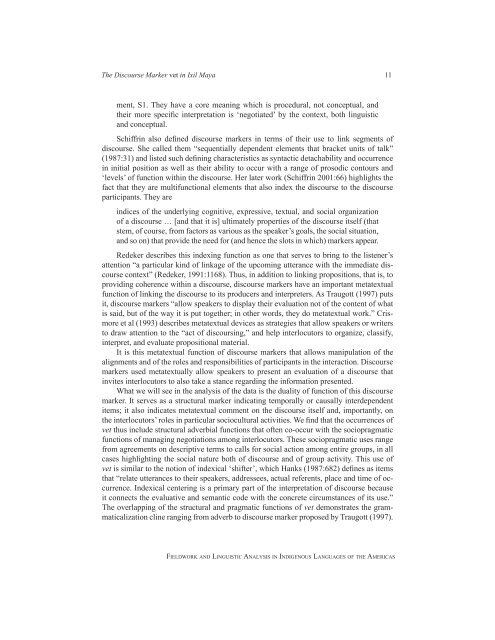Fieldwork and Linguistic Analysis in Indigenous ... - ScholarSpace
Fieldwork and Linguistic Analysis in Indigenous ... - ScholarSpace
Fieldwork and Linguistic Analysis in Indigenous ... - ScholarSpace
Create successful ePaper yourself
Turn your PDF publications into a flip-book with our unique Google optimized e-Paper software.
The Discourse Marker vet <strong>in</strong> Ixil Maya 11<br />
ment, S1. They have a core mean<strong>in</strong>g which is procedural, not conceptual, <strong>and</strong><br />
their more specific <strong>in</strong>terpretation is ‘negotiated’ by the context, both l<strong>in</strong>guistic<br />
<strong>and</strong> conceptual.<br />
Schiffr<strong>in</strong> also def<strong>in</strong>ed discourse markers <strong>in</strong> terms of their use to l<strong>in</strong>k segments of<br />
discourse. She called them “sequentially dependent elements that bracket units of talk”<br />
(1987:31) <strong>and</strong> listed such def<strong>in</strong><strong>in</strong>g characteristics as syntactic detachability <strong>and</strong> occurrence<br />
<strong>in</strong> <strong>in</strong>itial position as well as their ability to occur with a range of prosodic contours <strong>and</strong><br />
‘levels’ of function with<strong>in</strong> the discourse. Her later work (Schiffr<strong>in</strong> 2001:66) highlights the<br />
fact that they are multifunctional elements that also <strong>in</strong>dex the discourse to the discourse<br />
participants. They are<br />
<strong>in</strong>dices of the underly<strong>in</strong>g cognitive, expressive, textual, <strong>and</strong> social organization<br />
of a discourse … [<strong>and</strong> that it is] ultimately properties of the discourse itself (that<br />
stem, of course, from factors as various as the speaker’s goals, the social situation,<br />
<strong>and</strong> so on) that provide the need for (<strong>and</strong> hence the slots <strong>in</strong> which) markers appear.<br />
Redeker describes this <strong>in</strong>dex<strong>in</strong>g function as one that serves to br<strong>in</strong>g to the listener’s<br />
attention “a particular k<strong>in</strong>d of l<strong>in</strong>kage of the upcom<strong>in</strong>g utterance with the immediate discourse<br />
context” (Redeker, 1991:1168). Thus, <strong>in</strong> addition to l<strong>in</strong>k<strong>in</strong>g propositions, that is, to<br />
provid<strong>in</strong>g coherence with<strong>in</strong> a discourse, discourse markers have an important metatextual<br />
function of l<strong>in</strong>k<strong>in</strong>g the discourse to its producers <strong>and</strong> <strong>in</strong>terpreters. As Traugott (1997) puts<br />
it, discourse markers “allow speakers to display their evaluation not of the content of what<br />
is said, but of the way it is put together; <strong>in</strong> other words, they do metatextual work.” Crismore<br />
et al (1993) describes metatextual devices as strategies that allow speakers or writers<br />
to draw attention to the “act of discours<strong>in</strong>g,” <strong>and</strong> help <strong>in</strong>terlocutors to organize, classify,<br />
<strong>in</strong>terpret, <strong>and</strong> evaluate propositional material.<br />
It is this metatextual function of discourse markers that allows manipulation of the<br />
alignments <strong>and</strong> of the roles <strong>and</strong> responsibilities of participants <strong>in</strong> the <strong>in</strong>teraction. Discourse<br />
markers used metatextually allow speakers to present an evaluation of a discourse that<br />
<strong>in</strong>vites <strong>in</strong>terlocutors to also take a stance regard<strong>in</strong>g the <strong>in</strong>formation presented.<br />
What we will see <strong>in</strong> the analysis of the data is the duality of function of this discourse<br />
marker. It serves as a structural marker <strong>in</strong>dicat<strong>in</strong>g temporally or causally <strong>in</strong>terdependent<br />
items; it also <strong>in</strong>dicates metatextual comment on the discourse itself <strong>and</strong>, importantly, on<br />
the <strong>in</strong>terlocutors’ roles <strong>in</strong> particular sociocultural activities. We f<strong>in</strong>d that the occurrences of<br />
vet thus <strong>in</strong>clude structural adverbial functions that often co-occur with the sociopragmatic<br />
functions of manag<strong>in</strong>g negotiations among <strong>in</strong>terlocutors. These sociopragmatic uses range<br />
from agreements on descriptive terms to calls for social action among entire groups, <strong>in</strong> all<br />
cases highlight<strong>in</strong>g the social nature both of discourse <strong>and</strong> of group activity. This use of<br />
vet is similar to the notion of <strong>in</strong>dexical ‘shifter’, which Hanks (1987:682) def<strong>in</strong>es as items<br />
that “relate utterances to their speakers, addressees, actual referents, place <strong>and</strong> time of occurrence.<br />
Indexical center<strong>in</strong>g is a primary part of the <strong>in</strong>terpretation of discourse because<br />
it connects the evaluative <strong>and</strong> semantic code with the concrete circumstances of its use.”<br />
The overlapp<strong>in</strong>g of the structural <strong>and</strong> pragmatic functions of vet demonstrates the grammaticalization<br />
cl<strong>in</strong>e rang<strong>in</strong>g from adverb to discourse marker proposed by Traugott (1997).<br />
fieldwork <strong>and</strong> l<strong>in</strong>guistic analysis <strong>in</strong> <strong>in</strong>digenous languages of the americas

















